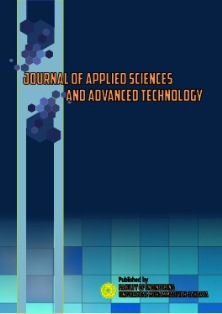The Influence Of Work Surface Roughness Caused By Fraising Machined With HSS Chies
DOI:
https://doi.org/10.24853/jasat.6.2.49-56Keywords:
surface roughness, cutting speed, cutting depth, analysis of varianceAbstract
The development of production techniques is required to produce good products that have standards for the products produced, both in terms of profile shape, size precision, surface roughness, hardness, material flexibility, and others that comply with standards. The surface roughness of a product can affect its functions, such as its level of precision and ability to accept loads. This research aims to find out how much influence cutting speed and depth of cut have on surface roughness with variations in cutting speed parameters of 21 meters/minute and 26 meters/minute and for AISI 4140 steel cutting speed parameters of 12 meters/minute and 17 meters/minute and cutting depths of 0.1 mm and 0.3 mm on four types of steel with End Mill cutting blades made from High-Speed Steel with a total of 4 flute cutting blades. Next, surface roughness testing and analysis of variance were carried out to determine the influence of parameters on surface roughness. The results obtained were that the largest average surface roughness, namely Ra = 5.33 µm, occurred on AISI 4140 steel at a cutting speed of 12 m/min with a cutting depth of 0.3 mm. Meanwhile, the smallest average surface roughness, namely Ra = 0.91 µm, occurred on AISI 1045 steel at a cutting speed of 21 m/min with a cutting depth of 0.1 mm. Next, an analysis of the variance method was also carried out with the following results: cutting speed only affected S45C steel because the value of Fcount>Ftable (13.18107506 > 5.32). The depth of cut does not have a significant effect on surface roughness on all types of steel because of the comparison results Fcount<Ftable. The interaction of cutting speed and cutting depth does not affect surface roughness because the comparison shows that Fcount <Ftable for all types of steel.Downloads
References
Harjanto, B., and Danar Susilo Wijayanto, dan, Pengaruh Sudut Penyayatan Dan Jumlah Mata Sayat Endmill Cutter Terhadap Tingkat Kekasaran Permukaan Baja St 40 Hasil Pemesinan Cnc Milling Tosuro Kontrol GSK 983 Ma-H.
Arfendi, 2021, “Optimasi Material Removal Rate (MRR) Baja ST 42 Pada Proses CNC Turning Dengan Menggunakan Metode Taguchi,” Politeknik Manufaktur Negeri Bangka Belitung.
Manik, P., Chrismianto, D., and Prayoga, P. F., 2023, “The Influence of SMAW Welding Current Variation on Tensile Strength, Corrosion Rate, and Microstructure of ST 42 Steel for Inner Bottom Plate Material in Ships,” International Journal of Marine Engineering Innovation and Research, 8(2).
Istiqlaliyah, H., and Ilham, M., 2021, “The Effectiveness of the Carburizing Process on ST 42 Steel With Variations of Donor Media,” Procedia of Engineering and Life Science, 1(1).
Kusmoko, A., Dahar, R. A., Li, H. J., and Hadi, S., 2014, “A Study Surface Layer and Hardness Produced by Induction Hardened S45C Steel,” Applied Mechanics and Materials, 664, pp. 43–47.
Kumar, R., Modi, A., Panda, A., Sahoo, A. K., Deep, A., Behra, P. K., and Tiwari, R., 2019, “Hard Turning on JIS S45C Structural Steel: An Experimental, Modelling and Optimisation Approach,” International Journal of Automotive and Mechanical Engineering, 16(4), pp. 7315–7340.
E. Satyarini, and B. Bawono, 2013, “Optimalisasi Sifat-Sifat Mekanik Material S45C,” Universitas Atma Jaya, Yogyakarta.
Nugrahan, G. I., 2017, “Karakteristik Baja AISI 1045 Hasil Pengerjaan Mesin Milling Dengan Proses Carburising Terhadap Sifat Mekanis,” Jurnal Teknik Mesin UBL, 5.
Susilo, B., and Nurrohkayati, A. S., 2022, “Carbide Tool Wear Analysis for Manufacturing Aisi 4140 Alloy Steel with 2D/3D Deform Simulation in PT Rejeki Sekawan Abadi,” Procedia of Engineering and Life Science, 2(2).
Kumar, A., Sharma, R., Kumar, S., and Verma, P., 2022, “A Review on Machining Performance of AISI 304 Steel,” Mater Today Proc, 56, pp. 2945–2951.
Sya’roni, M., Mufarida, N. A., and Finali, A., 2019, “Pengaruh Variasi Kecepatan Potong, Kedalaman Pemakanan Dan Jumlah Mata Pahat Terhadap Kekasaran Permukaan Stainless Steel Aisi 304 Pada Proses Milling,” Unmuh Jember.
Singh Bedi, S., Prasad Sahoo, S., Vikas, B., and Datta, S., 2021, “Influence of Cutting Speed on Dry Machinability of AISI 304 Stainless Steel,” Mater Today Proc, 38, pp. 2174–2180.
Junaidh, A. P., Yuvaraj, G., Peter, J., Bhuvaneshwari, V., Kanagasabapathi, and Karthik, K., 2018, “Influence of Process Parameters on the Machining Characteristics of Austensite Stainless Steel (AISI 304),” Mater Today Proc, 5(5), pp. 13321–13333.
Krar, Stephen F, Oswald, J. W., Amand, J. E. S., and S. F. Krar, 1990, Technology of Machine Tools, McGraw-Hill, New York.
Downloads
Published
Issue
Section
License
COPYRIGHT POLICY
The author(s) of an article published in the Journal of Applied Sciences and Advanced Technology (JASAT) retains ownership of the intellectual property rights in work (s).
PUBLISHING RIGHTS
The author(s) of an article published in the Journal of Applied Sciences and Advanced Technology (JASAT) have unrestricted publication rights. The authors give the Journal of Applied Sciences and Advanced Technology (JASAT) the right to publish the article and designate the Faculty of Engineering Universitas Muhammadiyah Jakarta Publishing as the original publisher of the article.
LICENSING POLICY
JASAT is an open-access journal that follows the Creative Commons Non-Commercial 4.0 International License (CC BY-NC 4.0), which states that:

Under this license, the reusers must give appropriate credit, provide a link to the license, and indicate if changes were made. Users may do so in any reasonable manner, but not in any way that suggests the licensor endorses users or their use.
Please take the time to read the whole license agreement (https://creativecommons.org/licenses/by-nc/4.0/). As long as reusers follow the license conditions, the owner cannot withdraw these freedoms. The following components are included under this license:
 Attribution: Users must provide appropriate attribution, including a link to the license, and indicate whether or not they made any modifications. Users are free to do so reasonably, but not in a manner that indicates the licensee approves of their usage.
Attribution: Users must provide appropriate attribution, including a link to the license, and indicate whether or not they made any modifications. Users are free to do so reasonably, but not in a manner that indicates the licensee approves of their usage.
 NonCommercial: Users may not use the material for commercial purposes.
NonCommercial: Users may not use the material for commercial purposes.












_2.png)


1.png)

2.png)
